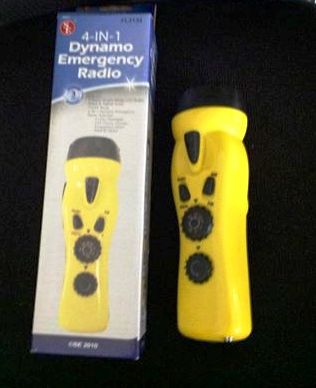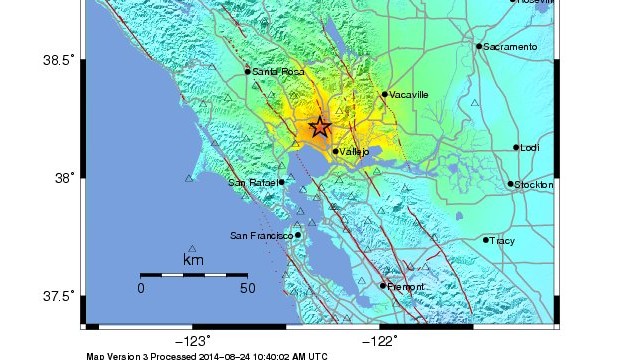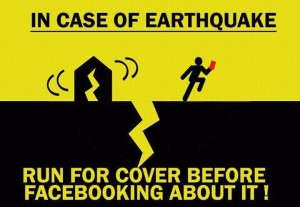
The star shows the location of the earthquake
The 6.1 earthquake early this morning was a wake up call for us all. A reminder that we live in earthquake country and need to be prepared. “Just a little reminder how small we really are on this planet. Time to get prepared. If we aren’t already.” said Christina Barnett Haas on our FB page. Kevin McIntosh checked in from across the bay, ” I live in Fairfield and was up looking out my upstairs window when it hit, it felt way worse than 89, I thought my house was going to come down” Glen Wandersee was one of the many who said ” What earthquake?”
Being prepared for ‘the big one’ has been our rallying cry for years yet we realize so many folks are not prepared. Sharon Kay Gustilo Meyer said “I woke up right before it happened. Ran to my mom’s room to make sure she was okay while it was happening. Didn’t go back to sleep right away. I stayed up and researched exactly what I needed for an emergency kit for two. I plan to go and make one today. Let this serve as a warning/reminder. WE LIVE IN EARTHQUAKE COUNTRY!! Better get them kits together.” We agree with Sharon that earthquake kits are important and here are a few things to do to prepare for the next one.
*Secure your free standing tall furnishings and water heater. News agencies reported a young child is in critical condition after the fire place fell on him during this morning’s quake. Prepare to prevent injuries now.

This 4-in-1 trim line device works as a flashlite, radio, siren, and mobile device charger through hand cranked technology
* Put shoes or slippers next to your bed. Should there be broken glass and you step in it you are immediately a victim and will need help, rather than being able to help others.
* Invest in a hand crank multi-use radio/ flashlite/ alarm/ charger to use should power go off and mobile devices run out of power.
* Keep cash on hand because of power outages many stores may not be able to run registers or process credit cards.
*Always have enough medication to last a month should there be a major disruption making refills unavailable
*Designate a contact person out of the area that all family members/ friends check in with since local phone access might be limited.
* Always keep 1/2 tank of gas in your vehicle since gas stations may be compromised and/ or have a run on filling up tanks.
* Keep your house & car keys in a specific location so you don’t have to search for them
*Grab one of the kids old backpacks and start adding basic supplies as you can. The backpack will be ready to go with you should you need to evacuate your home or work place. The important thing is to get started and not be overwhelmed in creating this emergency supply bag. Below are a few suggestions for supplies of which you might have some already in your home:
*Duct Tape *Heavy Duty Plastic Bags *Sturdy shoes *Good Socks *Heavy Duty Gloves *Indelible Pen *Notebook *Medications *Baby or Special Items *High Protein Foods Like Tuna Power Bars, etc *Bottled Water *Change of Clothes *Jacket *Copy of Documents In Ziplocks *First Aid Kit
From this list you can elaborate according to your own family’s needs.
In addition it is great to check with neighbors about what common tools you may have to share to help others: Hammers, Nails, Crowbar, Shovels, Rope, Saws, Drills, and so forth. Camping equipment is also provides an excellent stash of items that might be needed and used. Stockpiling some food to last a week or so is also a good idea along with 1 gallon of water per day per person. To keep these additional items secure and handy, consider purchasing a garbage can with wheels and secure top and keep it outside your home.
Do not automatically turn off your gas line unless you smell gas. If there is no problem with your gas line it could take days or weeks before you can get it turned back on since PGE will kept busy with priority calls. Be sure you have flashlites and batteries and do not use candles.
While earthquakes are common in California a 6.1 is definitely a wake up call for us all. News agencies report dozens of folks were injured closer to the epicenter in the Napa area. One young boy has been airlifted with critical injuries due to a heavy object falling on him. This is one of the easiest and important things to do to be prepared: SECURE YOUR FURNISHINGS. All high standing items such as dressers, mirrors, water heaters must be securely strapped down to prevent falling which causes the most injuries. In addition the Napa area suffered multiple fires, down wires and broken water lines. We need to be prepared. And we need to check on our neighbors after earthquakes, especially our seniors and those who live alone. Is the the prelude to ‘the big one’? No one knows for sure yet we do know aftershocks have, and will, continue. Firedispatch shows there were were no calls from residents asking for help after this morning’s event.
The government offers some good information on preparation and can be found HERE.

Members of SSF CERT joined in on National Night Out earlier this month. They offered information on preparedness and raffled some great prizes
Photo: Sonny Koya
In addition residents are encouraged to take the FREE Community Emergency Response Team Course which is available through of Fire Department. More information on this program can be found on our City Website CLICK HERE. To take this course you will find more registration information on the Parks & Recreation Leisure Guide CLICK HERE You can also call the CERT Hotline 829-4336 for information yet personal experience suggests making a stop by the SSFFD on South Canal more effective.
This mornings earthquake was ‘located at the eastern shore of San Pablo Bay between two major active fault systems: the Hayward-Rodgers Creek Fault system on the west and the Concord-Green Valley Fault system on the east. The earthquake occurred near the well-known West Napa Fault, and the less well known Carneros-Franklin Faults, which juxtapose different suites of rocks’per the USGS (United States Geological Survey)
The take away from this early morning earthquake reminds us the earth is a live and will continue to move and shake. And we must be prepared, not scared. Today is a good day to start gathering some supplies because we do know earthquakes will continue and will get bigger. ![]()
![]()
From the USGS regarding today’s quake: ![]()

Tectonic Summary
The earthquake lies within a 70-km-wide (44 miles) set of major faults of the San Andreas Fault system that forms the boundary between the Pacific and North American tectonic plates. The persistent northwestward movement of the Pacific plate relative to North America primarily causes right-lateral slip across the major faults, but also causes deformation between the major faults. The ongoing complex deformation field is revealed by modern geodetic surveys and earthquake patterns as well as the regional geologic structure. The earthquake is located at the eastern shore of San Pablo Bay between two major active fault systems: the Hayward-Rodgers Creek Fault system on the west and the Concord-Green Valley Fault system on the east. The earthquake occurred near the well-known West Napa Fault, and the less well known Carneros-Franklin Faults, which juxtapose different suites of rocks. Although there are several faults in the region of the earthquake, only the West Napa Fault is known to have displaced Holocene-age sediment — which is positive evidence of surface fault rupture in the last 11,000 years.
Historically, in this region shaking sufficient to seriously damage structures at Mare Island occurred during the M6.8 1868 Hayward Fault earthquake, the M7.8 1906 San Andreas Fault earthquake, and particularly during the M6.3 1898 Mare Island earthquake. The 1898 earthquake may have occurred about 20 km (12 miles) to the northwest on the southern Rodgers Creek Fault. Even larger nearby events than the 1898 earthquake can be expected in the future. In addition, the epicentral region of this earthquake is depicted on the USGS National Seismic Hazard Maps to have a high probability of strong shaking in the future.
The earthquake is located between two major, largely strike-slip fault systems. The Hayward-Rodgers Creek Fault system, which is approximately 7 km (4 miles) west of the site, generated damaging earthquakes in 1868 and probably in 1898. The Concord-Green Valley Fault system, which is 12 km (7 miles) east of the site, produced a M5.5 earthquake in 1954; while it has not generated a large historical event, there is strong evidence for recent pre-historic activity. The 1999 Working Group on California Earthquake Probabilities (WG99, 1999) concluded that the Hayward-Rodgers Creek Fault system has a 32 percent probability of generating a large earthquake (M6.7 to 7.4) by the year 2030, and the Concord-Green Valley Fault system has a 6 percent chance of generating a large earthquake (M≥6.7) in the same time period.
The earthquake occurred near the north shore of San Pablo Bay. The bayshore areas in the San Francisco Bay region are underlain by landfill and bay mud and have experienced disproportionately greater damage during historic earthquakes. Such damage is caused by soil failure in the fills and amplification of ground shaking by the soft bay mud.
To see the USGS list of earthquakes happening CLICK HERE
To read more from Everything South City on preparedness CLICK HERE

this moring i felt the after shock when i was in bed we that our south san francisco fire department will head down to in amerian canyon. i help for the resident in napa so they can get to there homes tonight.